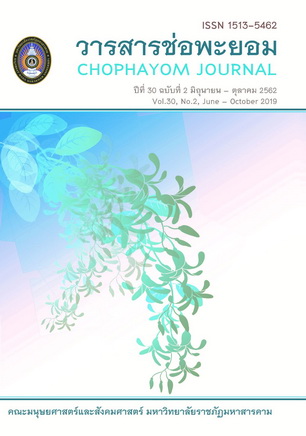An Analysis of the Structural Relationship Model for Self-Development of People in Sufficiency Economy Villages
Keywords:
Structural Relationship Model, Structural RStructural Equation Modeling, self-sufficiency, sufficiency economy villagesAbstract
The purposes of the research were to analyze structural relationship models for self-development of people in sufficiency economy villages. The research also wants to design a structural relationship model for self-development of people in sufficiency economy villages. The sample subjects of the study were 3,061 heads of 3,749 families from 38 sufficiency economy villages consisting of 10 excellent sufficiency economy villages and 28 good sufficiency economy villages. Taro Yamane formula was employed for calculating the sample size. The samples were selected by drawing technique. The research instrument used was an interview
form. The factors affecting self-sufficiency of the people in sufficiency economy villages were analyzed by data was analyzed by multiple linear regression and path analysis. The research results showed that the six major factors were age, number of the family members, self-relying, training, leadership and relationship of the family members. The percentage of the structural relationship model for self-development of the people in sufficiency economy villages was 79.60%. The findings indicated that the six factors affected self-sufficiency of the people in sufficiency economy villages significantly at the .05 level. They were age, number of the family members, self-relying, training, leadership and relationship of the family members. Lastly, the structural relationship model for self-development of the people in sufficiency economy villages was
consistent with the empirical data. Keywords : Structural Relationship Model, Structural Equation Modeling, self-sufficiency, sufficiency economy villages
References
ภูริปัญญา เกิดศรี. (2553). ปัจจัยความสำเร็จในการประยุกต์ปรัชญาเศรษฐกิจพอเพียงในเขตปฏิรูปที่ดิน: ศึกษากรณี ตำบลนิคมกระเสียว อำเภอด่านช้าง. วิทยานิพนธ์ รป.ม. กรุงเทพฯ : สถาบันบัณฑิตพัฒนบริหารศาสตร์.
มยุรี เสือคำราม. (2550). “เกษตรกรรมแนวเศรษฐกิจพอเพียง การเกษตรที่ให้ผลตอบแทนคุ้มค่าและคุ้มทุน,” เกษตรกรรมธรรมชาติ. 10(12) : 60-65.
วรรณี แกมเกตุ และคณะ. (2545). การพัฒนาตัวบ่งชี้ความสามารถในการพึ่งตนเองของครอบครัวและชุมชนชนบท. กรุงเทพฯ : ภาควิชาวิจัยและจิตวิทยาการศึกษา คณะครุศาสตร์ จุฬาลงกรณ์มหาวิทยาลัย.
สุวกิจ ศรีปัดถา และคณะ. (2530). กระบวนการพัฒนาชนบทจังหวัดมหาสารคาม. มหาสารคาม : ศูนย์ประสานงานการพัฒนาชนบทจังหวัดมหาสารคาม (สารคามพัฒนา).
สำนักงานประสานงานวิจัยเชิงบูรณาการ มหาวิทยาลัยแม่โจ้. (2556). เศรษฐกิจชุมชน. สืบค้นเมื่อ : 26 ตุลาคม 2556 จาก https://www.trf.mju.ac.th/lobby/lobby.php?Lpage=AT&id=AAT520102.php
Jöreskog, Karl G. and Sörbom, Dag. (1998). LISREL 8 : Structural Equation Modeling with the SIMPLIS Command Language. Chicago : Scientific Software International.






